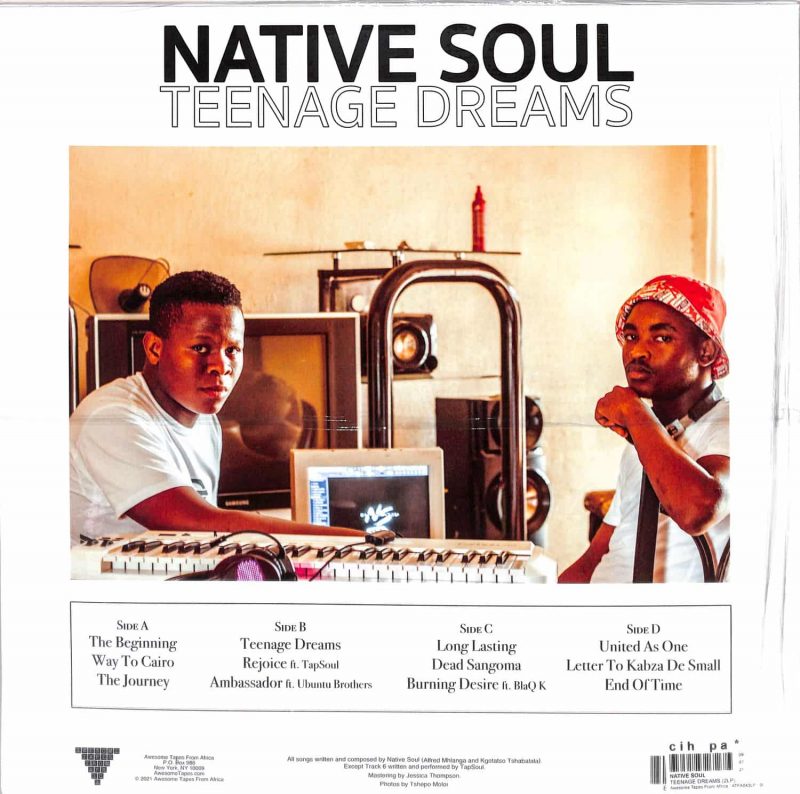Native Soul’s debut album ‘Teenage Dreams’ begins the future of amapiano
Image: Awesome Tapes From Africa
To say that South Africa may be experiencing a cultural Renaissance may not be completely unfounded. From the meme sensation of Jerusalema to Beyoncé dressed by Rich Mnisi, South Africa’s pop culture has never felt more prevalent in the first world. And with the success of Netflix shows Jiva and Blood & Water, the sound of South Africa’s popular music is going global. But this has been a steady progression. Artists like Moonchild Sanelly and Sho Madjozi have arrived as the definitive faces of contemporary South African pop around the world and the source of their sound, the underground sounds of amapiano and gqom, has followed suit by finding its way on the dance floors and decks of Europe. Amapiano in particular has emerged as the future sound of club music, and this success has brought about opportunities for South Africa’s emerging talent like never before. It’s the reason why Native Soul, the Pretoria-based teenage production duo made up of 19 year old Kgothatso Tshabalala and 18 year old Zakhele Mhlanga, have debuted on Los Angeles based label Awesome Tapes From Africa, a striking departure for a genre whose music is predominantly spread via WhatsApp groups. And for a debut, Teenage Dreams is impressively accomplished, placing its focus on dynamic, punchy production and unique attention to detail at a crucial point in amapiano’s inevitable transition into the mainstream.
Falling on the dustier side of the genre, Teenage Dreams pulls from the darker corners of the South African underground. It’s an album that feels simultaneously grassroots while sounding distinctly innovative, probably in part to Native Soul’s eschewing of the pop tropes that currently dominate amapiano. Teenage Dreams is a collection of relentless, long form formulations of amapiano’s signature log drum boom and hulking bass, accented with ominous synth riffs and moody, throbbing chords that add a satisfyingly rich sense of atmosphere to the genre’s typically looped structure. This investment in atmosphere adds to Native Soul’s sound what other producers have found in the addition of vocals and pop hooks; a sense of progression and evolution in the music that in this case, makes for something remarkably immersive. The album’s first act, starting with The Beginning and ending with the title track, play out like an extended introduction into the realm of Native Soul. They are pulsing, sans-vocal cuts that stretch on to the precipice of bleeding into each other, each sharing a DNA of hollow, throbbing bass and booming percussion. It’s almost as if each track builds upon the elements of the one before it, evolving through the motifs of amapiano before reaching its final form. The Beginning is all stuttering percussion and bass and by the time The Journey introduces the sort of house adjacent piano riff responsible for the genre’s nomenclature, a scrambled, mutant vocoder sample appears to locate Native Soul firmly in the genre’s future.
These first four tracks are followed by Rejoice, which brings about Teenage Dreams’s first and only instance of vocals. But rather than melody, Rejoice finds its voice in the form of chant-like vernacular vocalisations. Much of Teenage Dream’s success lies in the way it embraces the unexpected, bending tropes just enough to sound familiar but entirely unique. On Long Lasting, a Moroder-esque modular synth riff appears through the dust like a beam of sharp neon that continues to burn in the background for the track’s entire eight minute marathon. The synth work on this track is sublime, pulling from everything from techno to trance and melding them into Native Soul’s amapiano. For working in a form synonymous with its laid back vibe and rhythm, Native Soul are unafraid of melodrama, and often lean into moments that are designed to feel massive. Everything about Burning Desire (featuring BlQ K) is dialled up to eleven, playing with tension and release at its most intense. They understand the potential for this music to create transportive, almost sinister moments of theatre and vehemently explore this facet in their production. In a sense, they borrow the energy of amapiano’s higher-BPM cousin afro-tech and apply it here, making for music that screams peak time even though it moves at nothing over 110bpm. But for all their experimentation, Native Soul honour the roots of their genre. Late album track Letter To Kabza de Small is a sonic ode to an artist who has been dubbed the “King of Amapiano”, and as one of the more traditional formulations on the record, it’s a recognition of the past on their astronomical journey toward the future.
With Teenage Dreams, Native Soul position themselves as the future of a genre that is in the process of dissemination, with its countless interpolations and evolutions not only within its country of origin, but even more so elsewhere in the world. They begin an essential new chapter that keeps the soul of amapiano firmly planted on African soil while embracing its growth beyond its borders. With its transcendental, traditional rhythms and touches of euphoric club innovation, Teenage Dreams marks the arrival of the next generation of amapiano’s grassroots progenitors. And this generation has taken the interest of the first world and used it to formulate a more potent, more dynamic form of a genre that was born to express the township experience.
Listen to The Journey from Teenage Dreams below.
Follow Native Soul



